SpringBoot内嵌的Tomcat启动过程以及请求
1.springboot内嵌的tomcat的pom坐标


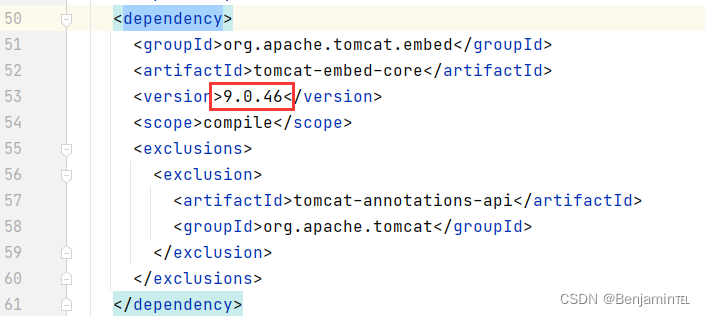
?启动后可以看到tomcat版本为9.0.46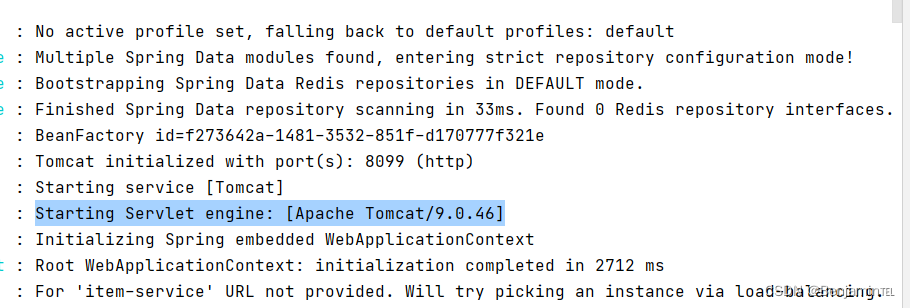
?2.springboot 内嵌tomcat启动流程
点击进入SpringApplication.run()方法里面
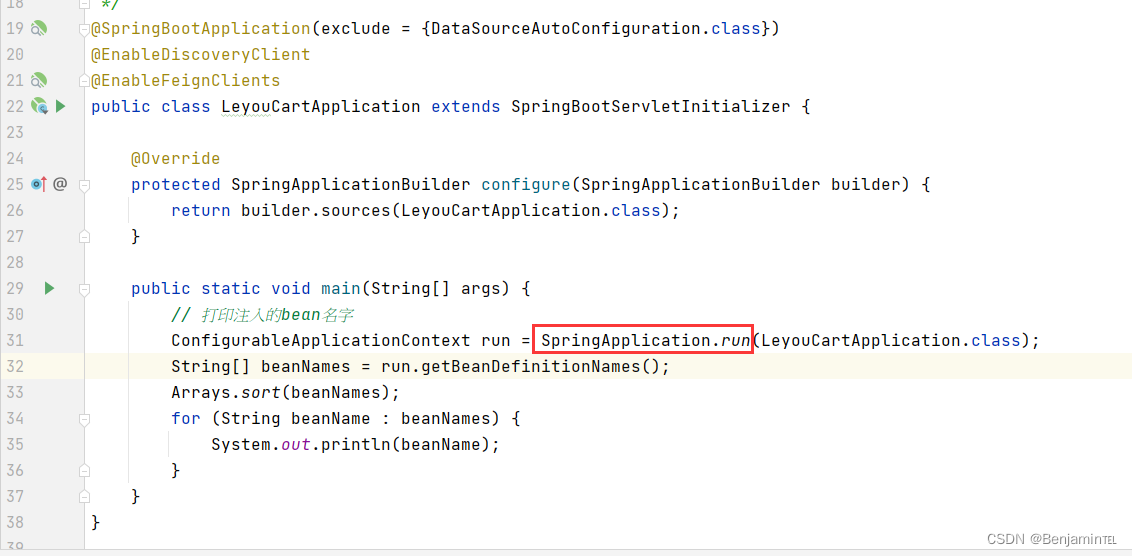


看这次tomcat启动相关的核心代码refreshContext(context);刷新上下文方法
public ConfigurableApplicationContext run(String... args) {
StopWatch stopWatch = new StopWatch();
stopWatch.start();
ConfigurableApplicationContext context = null;
configureHeadlessProperty();
SpringApplicationRunListeners listeners = getRunListeners(args);
listeners.starting();
try {
ApplicationArguments applicationArguments = new DefaultApplicationArguments(args);
ConfigurableEnvironment environment = prepareEnvironment(listeners, applicationArguments);
configureIgnoreBeanInfo(environment);
Banner printedBanner = printBanner(environment);
context = createApplicationContext();
prepareContext(context, environment, listeners, applicationArguments, printedBanner);
// 此次的核心代码是刷新上下文方法
refreshContext(context);
afterRefresh(context, applicationArguments);
stopWatch.stop();
if (this.logStartupInfo) {
new StartupInfoLogger(this.mainApplicationClass).logStarted(getApplicationLog(), stopWatch);
}
listeners.started(context);
callRunners(context, applicationArguments);
}
catch (Throwable ex) {
handleRunFailure(context, ex, listeners);
throw new IllegalStateException(ex);
}
try {
listeners.running(context);
}
catch (Throwable ex) {
handleRunFailure(context, ex, null);
throw new IllegalStateException(ex);
}
return context;
}进入 私有方法refreshContext
private void refreshContext(ConfigurableApplicationContext context) {
if (this.registerShutdownHook) {
try {
context.registerShutdownHook();
}
catch (AccessControlException ex) {
// Not allowed in some environments.
}
}
// 核心方法,继续进入
refresh((ApplicationContext) context);
}@Deprecated
protected void refresh(ApplicationContext applicationContext) {
Assert.isInstanceOf(ConfigurableApplicationContext.class, applicationContext);
// 核心代码,继续进入方法
refresh((ConfigurableApplicationContext) applicationContext);
}进入refresh方法
protected void refresh(ConfigurableApplicationContext applicationContext) {
// 核心方法,查看调用的方法refresh()
applicationContext.refresh();
}查看refresh方法,有三个实现类,进入默认的实现类ServletWebServerApplicationContext,定位到实现方法


@Override
public final void refresh() throws BeansException, IllegalStateException {
try {
// 进入父类refresh
super.refresh();
}
catch (RuntimeException ex) {
WebServer webServer = this.webServer;
if (webServer != null) {
webServer.stop();
}
throw ex;
}
}?看onRefresh()方法
@Override
public void refresh() throws BeansException, IllegalStateException {
synchronized (this.startupShutdownMonitor) {
// Prepare this context for refreshing.
prepareRefresh();
// Tell the subclass to refresh the internal bean factory.
ConfigurableListableBeanFactory beanFactory = obtainFreshBeanFactory();
// Prepare the bean factory for use in this context.
prepareBeanFactory(beanFactory);
try {
// Allows post-processing of the bean factory in context subclasses.
postProcessBeanFactory(beanFactory);
// Invoke factory processors registered as beans in the context.
invokeBeanFactoryPostProcessors(beanFactory);
// Register bean processors that intercept bean creation.
registerBeanPostProcessors(beanFactory);
// Initialize message source for this context.
initMessageSource();
// Initialize event multicaster for this context.
initApplicationEventMulticaster();
// 我们进入这个方法
// Initialize other special beans in specific context subclasses.
onRefresh();
// Check for listener beans and register them.
registerListeners();
// Instantiate all remaining (non-lazy-init) singletons.
finishBeanFactoryInitialization(beanFactory);
// Last step: publish corresponding event.
finishRefresh();
}
catch (BeansException ex) {
if (logger.isWarnEnabled()) {
logger.warn("Exception encountered during context initialization - " +
"cancelling refresh attempt: " + ex);
}
// Destroy already created singletons to avoid dangling resources.
destroyBeans();
// Reset 'active' flag.
cancelRefresh(ex);
// Propagate exception to caller.
throw ex;
}
finally {
// Reset common introspection caches in Spring's core, since we
// might not ever need metadata for singleton beans anymore...
resetCommonCaches();
}
}
}?找到子类的实现方法:

@Override
protected void onRefresh() {
super.onRefresh();
try {
// 核心代码,创建web服务器
createWebServer();
}
catch (Throwable ex) {
throw new ApplicationContextException("Unable to start web server", ex);
}
}进入createWebServer方法,ServletContext、WebServer在tomcat启动的时候一定为空,还没有初始化完成,会进入if代码块执行
private void createWebServer() {
WebServer webServer = this.webServer;
// tomcat启动servletContext才进行创建
ServletContext servletContext = getServletContext();
if (webServer == null && servletContext == null) {
ServletWebServerFactory factory = getWebServerFactory();
// 核心代码,通过工厂获取一个WebServer实例
this.webServer = factory.getWebServer(getSelfInitializer());
getBeanFactory().registerSingleton("webServerGracefulShutdown",
new WebServerGracefulShutdownLifecycle(this.webServer));
getBeanFactory().registerSingleton("webServerStartStop",
new WebServerStartStopLifecycle(this, this.webServer));
}
else if (servletContext != null) {
try {
getSelfInitializer().onStartup(servletContext);
}
catch (ServletException ex) {
throw new ApplicationContextException("Cannot initialize servlet context", ex);
}
}
initPropertySources();
}?getWebServer方法需要参数,该参数是一个方法getSelfInitializer(),找到
private org.springframework.boot.web.servlet.ServletContextInitializer getSelfInitializer() {
// 方法引用,ServletContextInitializer是一个函数是接口,通过方法引用返回一个实现
// ServletContextInitializer的一个实现子类,作用同匿名内部类。
return this::selfInitialize;
}函数式接口:
@FunctionalInterface
public interface ServletContextInitializer {
/**
* Configure the given {@link ServletContext} with any servlets, filters, listeners
* context-params and attributes necessary for initialization.
* @param servletContext the {@code ServletContext} to initialize
* @throws ServletException if any call against the given {@code ServletContext}
* throws a {@code ServletException}
*/
void onStartup(ServletContext servletContext) throws ServletException;
}this::selfInitialize就是实例::方法名调用方式,this代表当前对象,selfInitialize是this(ServletWebServerApplicationContext)对象的一个私有方法
private void selfInitialize(ServletContext servletContext) throws ServletException {
prepareWebApplicationContext(servletContext);
registerApplicationScope(servletContext);
WebApplicationContextUtils.registerEnvironmentBeans(getBeanFactory(), servletContext);
for (ServletContextInitializer beans : getServletContextInitializerBeans()) {
beans.onStartup(servletContext);
}
}继续进入getWebServer,发现是一个接口,有三个实现类Jetty、Tomcat、UnderTow,我们是Tomcat服务器,进入TomcatServletWebServerFactory中的实现方法
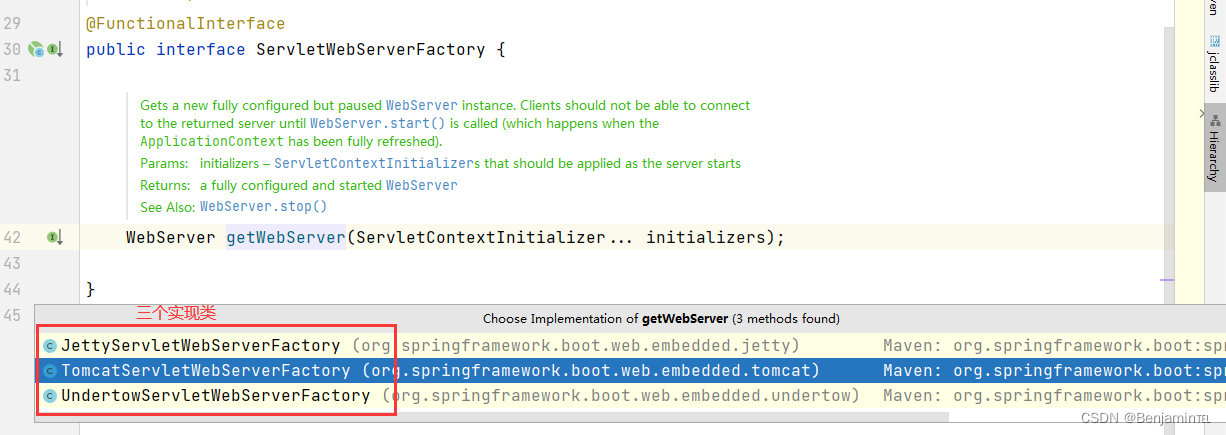
@Override
public WebServer getWebServer(ServletContextInitializer... initializers) {
if (this.disableMBeanRegistry) {
Registry.disableRegistry();
}
Tomcat tomcat = new Tomcat();
File baseDir = (this.baseDirectory != null) ? this.baseDirectory : createTempDir("tomcat");
// 用于设置临时文件的目录,这些目录用于存放JSP生成的源代码及Class文件x
tomcat.setBaseDir(baseDir.getAbsolutePath());
Connector connector = new Connector(this.protocol);
connector.setThrowOnFailure(true);
tomcat.getService().addConnector(connector);
customizeConnector(connector);
// 用于设置链接器,包括协议、I/0、端口、压缩、加密等等
tomcat.setConnector(connector);
// 是否自动部署
tomcat.getHost().setAutoDeploy(false);
configureEngine(tomcat.getEngine());
for (Connector additionalConnector : this.additionalTomcatConnectors) {
tomcat.getService().addConnector(additionalConnector);
}
prepareContext(tomcat.getHost(), initializers);
// 核心代码
return getTomcatWebServer(tomcat);
}protected TomcatWebServer getTomcatWebServer(Tomcat tomcat) {
return new TomcatWebServer(tomcat, getPort() >= 0, getShutdown());
}进入TomcatWebServer构造方法
public TomcatWebServer(Tomcat tomcat, boolean autoStart, Shutdown shutdown) {
Assert.notNull(tomcat, "Tomcat Server must not be null");
this.tomcat = tomcat;
this.autoStart = autoStart;
this.gracefulShutdown = (shutdown == Shutdown.GRACEFUL) ? new GracefulShutdown(tomcat) : null;
// 核心代码
initialize();
}?进入initialize()方法
private void initialize() throws WebServerException {
logger.info("Tomcat initialized with port(s): " + getPortsDescription(false));
synchronized (this.monitor) {
try {
addInstanceIdToEngineName();
Context context = findContext();
context.addLifecycleListener((event) -> {
if (context.equals(event.getSource()) && Lifecycle.START_EVENT.equals(event.getType())) {
// Remove service connectors so that protocol binding doesn't
// happen when the service is started.
removeServiceConnectors();
}
});
// 核心代码
// Start the server to trigger initialization listeners
this.tomcat.start();
// We can re-throw failure exception directly in the main thread
rethrowDeferredStartupExceptions();
try {
ContextBindings.bindClassLoader(context, context.getNamingToken(), getClass().getClassLoader());
}
catch (NamingException ex) {
// Naming is not enabled. Continue
}
// Unlike Jetty, all Tomcat threads are daemon threads. We create a
// blocking non-daemon to stop immediate shutdown
startDaemonAwaitThread();
}
catch (Exception ex) {
stopSilently();
destroySilently();
throw new WebServerException("Unable to start embedded Tomcat", ex);
}
}
}public void start() throws LifecycleException {
getServer();
// 核心代码
server.start();
}进入start()方法,找到LifecycleBase实现类方法

?LifecycleBase类中init();startInternal();两个核心方法
@Override
public final synchronized void start() throws LifecycleException {
if (LifecycleState.STARTING_PREP.equals(state) || LifecycleState.STARTING.equals(state) ||
LifecycleState.STARTED.equals(state)) {
if (log.isDebugEnabled()) {
Exception e = new LifecycleException();
log.debug(sm.getString("lifecycleBase.alreadyStarted", toString()), e);
} else if (log.isInfoEnabled()) {
log.info(sm.getString("lifecycleBase.alreadyStarted", toString()));
}
return;
}
if (state.equals(LifecycleState.NEW)) {
// 核心代码1
init();
} else if (state.equals(LifecycleState.FAILED)) {
stop();
} else if (!state.equals(LifecycleState.INITIALIZED) &&
!state.equals(LifecycleState.STOPPED)) {
invalidTransition(Lifecycle.BEFORE_START_EVENT);
}
try {
setStateInternal(LifecycleState.STARTING_PREP, null, false);
// 核心代码2
startInternal();
if (state.equals(LifecycleState.FAILED)) {
// This is a 'controlled' failure. The component put itself into the
// FAILED state so call stop() to complete the clean-up.
stop();
} else if (!state.equals(LifecycleState.STARTING)) {
// Shouldn't be necessary but acts as a check that sub-classes are
// doing what they are supposed to.
invalidTransition(Lifecycle.AFTER_START_EVENT);
} else {
setStateInternal(LifecycleState.STARTED, null, false);
}
} catch (Throwable t) {
// This is an 'uncontrolled' failure so put the component into the
// FAILED state and throw an exception.
handleSubClassException(t, "lifecycleBase.startFail", toString());
}
}?init()方法
@Override
public final synchronized void init() throws LifecycleException {
if (!state.equals(LifecycleState.NEW)) {
invalidTransition(Lifecycle.BEFORE_INIT_EVENT);
}
try {
setStateInternal(LifecycleState.INITIALIZING, null, false);
// 核心代码
initInternal();
setStateInternal(LifecycleState.INITIALIZED, null, false);
} catch (Throwable t) {
handleSubClassException(t, "lifecycleBase.initFail", toString());
}
}initInternal有很多实现类,看组件Connector中的实现方法
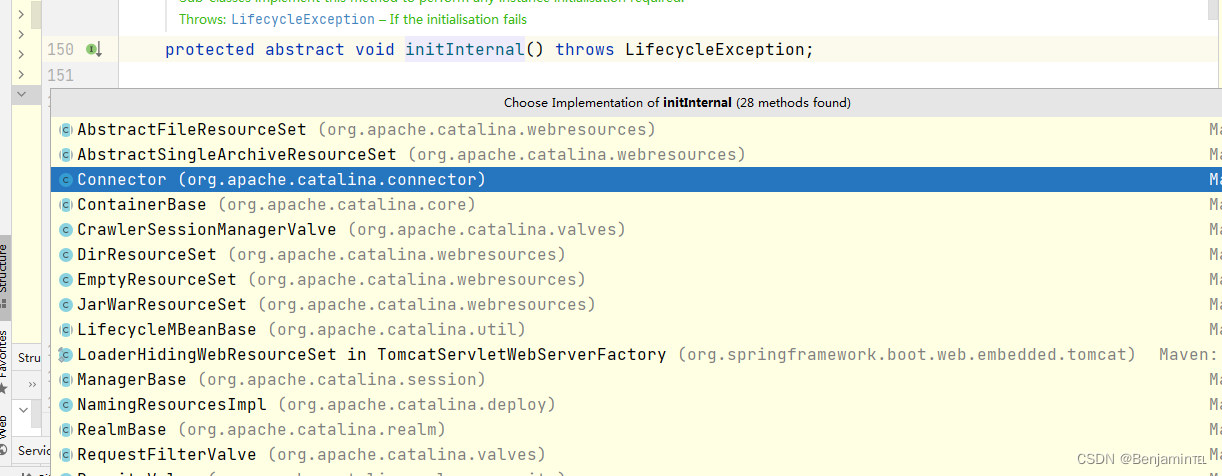
?组件Connector类型方法
@Override
protected void initInternal() throws LifecycleException {
super.initInternal();
if (protocolHandler == null) {
throw new LifecycleException(
sm.getString("coyoteConnector.protocolHandlerInstantiationFailed"));
}
// Initialize adapter
adapter = new CoyoteAdapter(this);
protocolHandler.setAdapter(adapter);
if (service != null) {
protocolHandler.setUtilityExecutor(service.getServer().getUtilityExecutor());
}
// Make sure parseBodyMethodsSet has a default
if (null == parseBodyMethodsSet) {
setParseBodyMethods(getParseBodyMethods());
}
if (protocolHandler.isAprRequired() && !AprStatus.isInstanceCreated()) {
throw new LifecycleException(sm.getString("coyoteConnector.protocolHandlerNoAprListener",
getProtocolHandlerClassName()));
}
if (protocolHandler.isAprRequired() && !AprStatus.isAprAvailable()) {
throw new LifecycleException(sm.getString("coyoteConnector.protocolHandlerNoAprLibrary",
getProtocolHandlerClassName()));
}
if (AprStatus.isAprAvailable() && AprStatus.getUseOpenSSL() &&
protocolHandler instanceof AbstractHttp11JsseProtocol) {
AbstractHttp11JsseProtocol<?> jsseProtocolHandler =
(AbstractHttp11JsseProtocol<?>) protocolHandler;
if (jsseProtocolHandler.isSSLEnabled() &&
jsseProtocolHandler.getSslImplementationName() == null) {
// OpenSSL is compatible with the JSSE configuration, so use it if APR is available
jsseProtocolHandler.setSslImplementationName(OpenSSLImplementation.class.getName());
}
}
try {
// 核心方法
protocolHandler.init();
} catch (Exception e) {
throw new LifecycleException(
sm.getString("coyoteConnector.protocolHandlerInitializationFailed"), e);
}
}进入实现类AbstractProtocol中init()方法
@Override
public void init() throws Exception {
if (getLog().isInfoEnabled()) {
getLog().info(sm.getString("abstractProtocolHandler.init", getName()));
logPortOffset();
}
if (oname == null) {
// Component not pre-registered so register it
oname = createObjectName();
if (oname != null) {
Registry.getRegistry(null, null).registerComponent(this, oname, null);
}
}
if (this.domain != null) {
ObjectName rgOname = new ObjectName(domain + ":type=GlobalRequestProcessor,name=" + getName());
this.rgOname = rgOname;
Registry.getRegistry(null, null).registerComponent(
getHandler().getGlobal(), rgOname, null);
}
String endpointName = getName();
endpoint.setName(endpointName.substring(1, endpointName.length()-1));
endpoint.setDomain(domain);
// 核心代码
endpoint.init();
}进入endpoint.init()方法
public final void init() throws Exception {
if (bindOnInit) {
// 核心代码
bindWithCleanup();
bindState = BindState.BOUND_ON_INIT;
}
if (this.domain != null) {
// Register endpoint (as ThreadPool - historical name)
oname = new ObjectName(domain + ":type=ThreadPool,name=\"" + getName() + "\"");
Registry.getRegistry(null, null).registerComponent(this, oname, null);
ObjectName socketPropertiesOname = new ObjectName(domain +
":type=SocketProperties,name=\"" + getName() + "\"");
socketProperties.setObjectName(socketPropertiesOname);
Registry.getRegistry(null, null).registerComponent(socketProperties, socketPropertiesOname, null);
for (SSLHostConfig sslHostConfig : findSslHostConfigs()) {
registerJmx(sslHostConfig);
}
}
}
进入bindWithCleanup方法里面?
private void bindWithCleanup() throws Exception {
try {
// 核心代码
bind();
} catch (Throwable t) {
// Ensure open sockets etc. are cleaned up if something goes
// wrong during bind
ExceptionUtils.handleThrowable(t);
unbind();
throw t;
}
}@Override
public void bind() throws Exception {
// 核心代码
initServerSocket();
setStopLatch(new CountDownLatch(1));
// Initialize SSL if needed
initialiseSsl();
selectorPool.open(getName());
}初始化Socket?
protected void initServerSocket() throws Exception {
if (getUseInheritedChannel()) {
// Retrieve the channel provided by the OS
Channel ic = System.inheritedChannel();
if (ic instanceof ServerSocketChannel) {
serverSock = (ServerSocketChannel) ic;
}
if (serverSock == null) {
throw new IllegalArgumentException(sm.getString("endpoint.init.bind.inherited"));
}
} else if (getUnixDomainSocketPath() != null) {
SocketAddress sa = JreCompat.getInstance().getUnixDomainSocketAddress(getUnixDomainSocketPath());
serverSock = JreCompat.getInstance().openUnixDomainServerSocketChannel();
serverSock.bind(sa, getAcceptCount());
if (getUnixDomainSocketPathPermissions() != null) {
Path path = Paths.get(getUnixDomainSocketPath());
Set<PosixFilePermission> permissions =
PosixFilePermissions.fromString(getUnixDomainSocketPathPermissions());
if (path.getFileSystem().supportedFileAttributeViews().contains("posix")) {
FileAttribute<Set<PosixFilePermission>> attrs = PosixFilePermissions.asFileAttribute(permissions);
Files.setAttribute(path, attrs.name(), attrs.value());
} else {
java.io.File file = path.toFile();
if (permissions.contains(PosixFilePermission.OTHERS_READ) && !file.setReadable(true, false)) {
log.warn(sm.getString("endpoint.nio.perms.readFail", file.getPath()));
}
if (permissions.contains(PosixFilePermission.OTHERS_WRITE) && !file.setWritable(true, false)) {
log.warn(sm.getString("endpoint.nio.perms.writeFail", file.getPath()));
}
}
}
} else {
serverSock = ServerSocketChannel.open();
socketProperties.setProperties(serverSock.socket());
InetSocketAddress addr = new InetSocketAddress(getAddress(), getPortWithOffset());
serverSock.bind(addr, getAcceptCount());
}
serverSock.configureBlocking(true); //mimic APR behavior
}startInternal();
看下这个方法,找到Connector里面的startInternal()方法实现
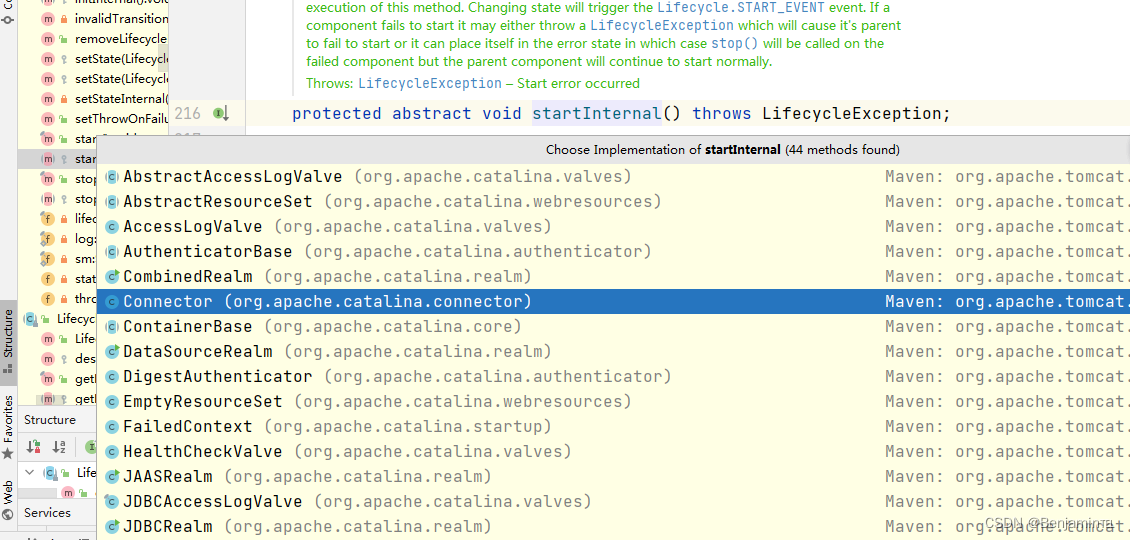
@Override
protected void startInternal() throws LifecycleException {
// Validate settings before starting
String id = (protocolHandler != null) ? protocolHandler.getId() : null;
if (id == null && getPortWithOffset() < 0) {
throw new LifecycleException(sm.getString(
"coyoteConnector.invalidPort", Integer.valueOf(getPortWithOffset())));
}
setState(LifecycleState.STARTING);
try {
// 核心代码
protocolHandler.start();
} catch (Exception e) {
throw new LifecycleException(
sm.getString("coyoteConnector.protocolHandlerStartFailed"), e);
}
}进入protocolHandler.start();方法里面。进入AbstractProtocol里面的实现方法

@Override
public void start() throws Exception {
if (getLog().isInfoEnabled()) {
getLog().info(sm.getString("abstractProtocolHandler.start", getName()));
logPortOffset();
}
// 核心代码
endpoint.start();
monitorFuture = getUtilityExecutor().scheduleWithFixedDelay(
() -> {
if (!isPaused()) {
startAsyncTimeout();
}
}, 0, 60, TimeUnit.SECONDS);
}找到endpoint.start()方法
public final void start() throws Exception {
if (bindState == BindState.UNBOUND) {
bindWithCleanup();
bindState = BindState.BOUND_ON_START;
}
// 核心代码
startInternal();
}进入这个实现类里,找到实现方法

?
@Override
public void startInternal() throws Exception {
if (!running) {
running = true;
paused = false;
if (socketProperties.getProcessorCache() != 0) {
processorCache = new SynchronizedStack<>(SynchronizedStack.DEFAULT_SIZE,
socketProperties.getProcessorCache());
}
if (socketProperties.getEventCache() != 0) {
eventCache = new SynchronizedStack<>(SynchronizedStack.DEFAULT_SIZE,
socketProperties.getEventCache());
}
if (socketProperties.getBufferPool() != 0) {
nioChannels = new SynchronizedStack<>(SynchronizedStack.DEFAULT_SIZE,
socketProperties.getBufferPool());
}
// Create worker collection
if (getExecutor() == null) {
createExecutor();
}
initializeConnectionLatch();
// 核心代码 *******
// Start poller thread
poller = new Poller();
Thread pollerThread = new Thread(poller, getName() + "-ClientPoller");
// 设置进程的优先级
pollerThread.setPriority(threadPriority);
// 守护线程:当非守护线程销毁的时候,守护线程跟着销毁。当运行的唯一线程是守护线程时,
// Java虚拟机将退出
pollerThread.setDaemon(true);
// 开启线程
pollerThread.start();
startAcceptorThread();
}
}Poller类是什么?
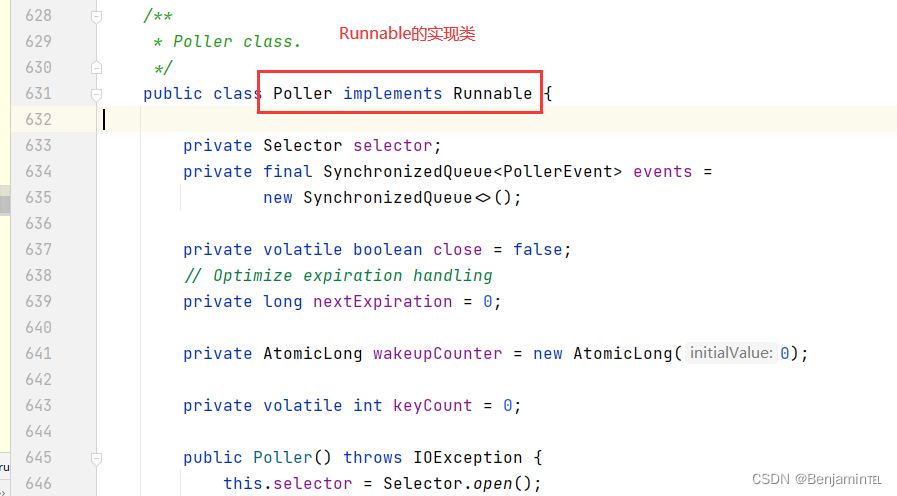
Poller里面的run方法
@Override
public void run() {
// Loop until destroy() is called
// 核心代码1 轮询
while (true) {
boolean hasEvents = false;
try {
if (!close) {
hasEvents = events();
if (wakeupCounter.getAndSet(-1) > 0) {
// If we are here, means we have other stuff to do
// Do a non blocking select
keyCount = selector.selectNow();
} else {
keyCount = selector.select(selectorTimeout);
}
wakeupCounter.set(0);
}
if (close) {
events();
timeout(0, false);
try {
selector.close();
} catch (IOException ioe) {
log.error(sm.getString("endpoint.nio.selectorCloseFail"), ioe);
}
break;
}
// Either we timed out or we woke up, process events first
if (keyCount == 0) {
hasEvents = (hasEvents | events());
}
} catch (Throwable x) {
ExceptionUtils.handleThrowable(x);
log.error(sm.getString("endpoint.nio.selectorLoopError"), x);
continue;
}
Iterator<SelectionKey> iterator =
keyCount > 0 ? selector.selectedKeys().iterator() : null;
// Walk through the collection of ready keys and dispatch
// any active event.
while (iterator != null && iterator.hasNext()) {
SelectionKey sk = iterator.next();
iterator.remove();
NioSocketWrapper socketWrapper = (NioSocketWrapper) sk.attachment();
// Attachment may be null if another thread has called
// cancelledKey()
if (socketWrapper != null) {
// 核心代码2
processKey(sk, socketWrapper);
}
}
// Process timeouts
timeout(keyCount,hasEvents);
}
getStopLatch().countDown();
}启动一个Poller线程轮询监听NIO接收的请求,直到执行核心代码2processKey(sk, socketWrapper);Poller类会轮询监听Socket连接,到这里tomcat算启动成功啦。
springboot嵌入tomcat处理请求的过程
主要看下Poller类中的processKey方法,我们发起一个请求怎么处理的呢?
processKey方法
protected void processKey(SelectionKey sk, NioSocketWrapper socketWrapper) {
try {
if (close) {
cancelledKey(sk, socketWrapper);
} else if (sk.isValid() && socketWrapper != null) {
if (sk.isReadable() || sk.isWritable()) {
if (socketWrapper.getSendfileData() != null) {
processSendfile(sk, socketWrapper, false);
} else {
unreg(sk, socketWrapper, sk.readyOps());
boolean closeSocket = false;
// Read goes before write
if (sk.isReadable()) {
if (socketWrapper.readOperation != null) {
// 核心代码
if (!socketWrapper.readOperation.process()) {
closeSocket = true;
}
// 核心代码
} else if (!processSocket(socketWrapper, SocketEvent.OPEN_READ, true)) {
closeSocket = true;
}
}
if (!closeSocket && sk.isWritable()) {
if (socketWrapper.writeOperation != null) {
if (!socketWrapper.writeOperation.process()) {
closeSocket = true;
}
} else if (!processSocket(socketWrapper, SocketEvent.OPEN_WRITE, true)) {
closeSocket = true;
}
}
if (closeSocket) {
cancelledKey(sk, socketWrapper);
}
}
}
} else {
// Invalid key
cancelledKey(sk, socketWrapper);
}
} catch (CancelledKeyException ckx) {
cancelledKey(sk, socketWrapper);
} catch (Throwable t) {
ExceptionUtils.handleThrowable(t);
log.error(sm.getString("endpoint.nio.keyProcessingError"), t);
}
}进入processSocket方法
public boolean processSocket(SocketWrapperBase<S> socketWrapper,
SocketEvent event, boolean dispatch) {
try {
if (socketWrapper == null) {
return false;
}
// 核心代码 线程
SocketProcessorBase<S> sc = null;
if (processorCache != null) {
sc = processorCache.pop();
}
if (sc == null) {
sc = createSocketProcessor(socketWrapper, event);
} else {
sc.reset(socketWrapper, event);
}
// 核心代码 获取线程池,通过线程池执行
Executor executor = getExecutor();
if (dispatch && executor != null) {
executor.execute(sc);
} else {
sc.run();
}
} catch (RejectedExecutionException ree) {
getLog().warn(sm.getString("endpoint.executor.fail", socketWrapper) , ree);
return false;
} catch (Throwable t) {
ExceptionUtils.handleThrowable(t);
// This means we got an OOM or similar creating a thread, or that
// the pool and its queue are full
getLog().error(sm.getString("endpoint.process.fail"), t);
return false;
}
return true;
}
看看SocketProcessBase是什么?? 实现了Runnable接口?
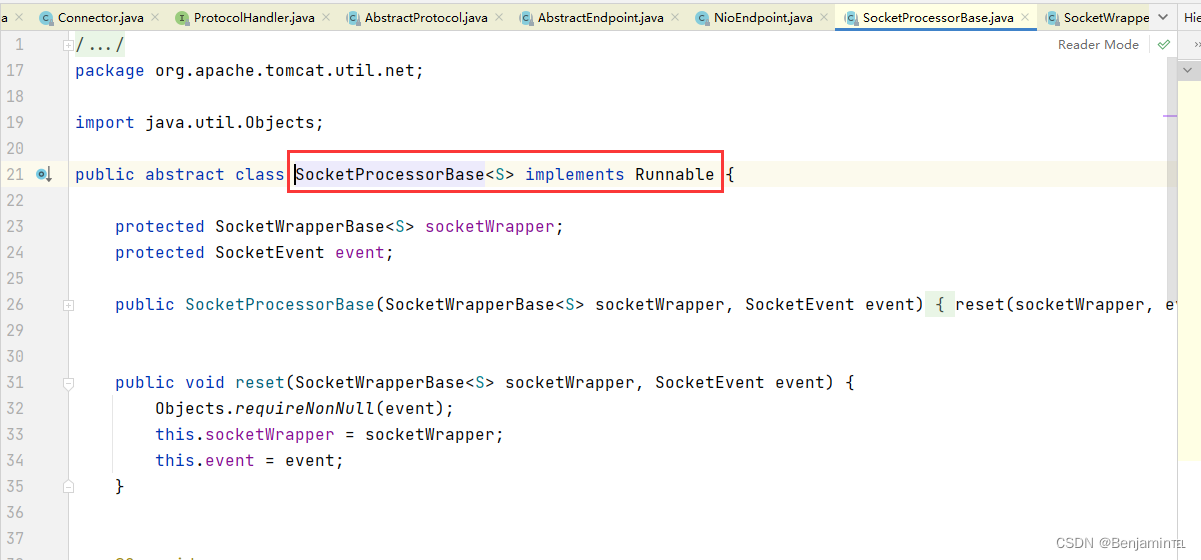
看下SocketProcessBase的run()方法
@Override
public final void run() {
synchronized (socketWrapper) {
// It is possible that processing may be triggered for read and
// write at the same time. The sync above makes sure that processing
// does not occur in parallel. The test below ensures that if the
// first event to be processed results in the socket being closed,
// the subsequent events are not processed.
if (socketWrapper.isClosed()) {
return;
}
// 核心代码
doRun();
}
}看下doRun()方法
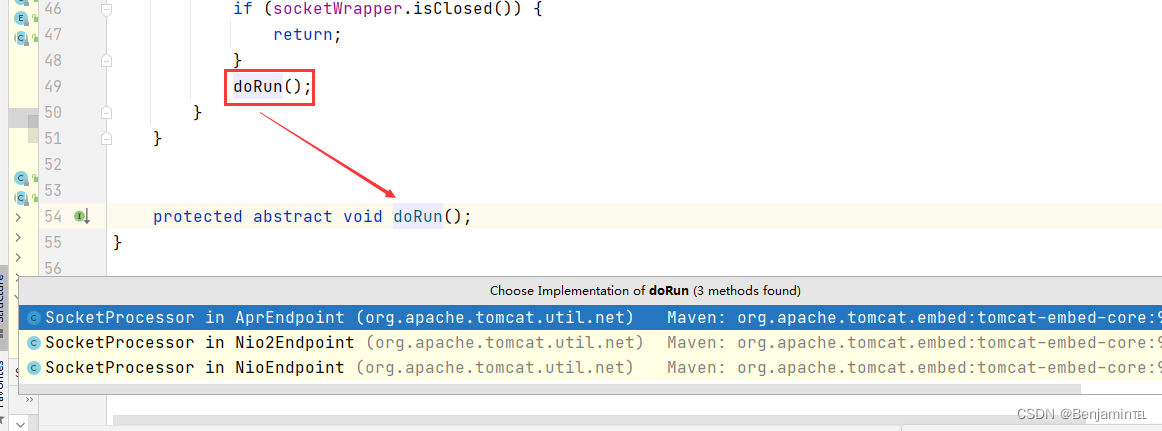
找到过滤器链ApplicationFilterChain,找到doFilter()方法
@Override
public void doFilter(ServletRequest request, ServletResponse response)
throws IOException, ServletException {
if( Globals.IS_SECURITY_ENABLED ) {
final ServletRequest req = request;
final ServletResponse res = response;
try {
java.security.AccessController.doPrivileged(
(java.security.PrivilegedExceptionAction<Void>) () -> {
// 核心代码
internalDoFilter(req,res);
return null;
}
);
} catch( PrivilegedActionException pe) {
Exception e = pe.getException();
if (e instanceof ServletException)
throw (ServletException) e;
else if (e instanceof IOException)
throw (IOException) e;
else if (e instanceof RuntimeException)
throw (RuntimeException) e;
else
throw new ServletException(e.getMessage(), e);
}
} else {
internalDoFilter(request,response);
}
}定位到internalDoFilter()方法
private void internalDoFilter(ServletRequest request,
ServletResponse response)
throws IOException, ServletException {
// Call the next filter if there is one
if (pos < n) {
ApplicationFilterConfig filterConfig = filters[pos++];
try {
Filter filter = filterConfig.getFilter();
if (request.isAsyncSupported() && "false".equalsIgnoreCase(
filterConfig.getFilterDef().getAsyncSupported())) {
request.setAttribute(Globals.ASYNC_SUPPORTED_ATTR, Boolean.FALSE);
}
if( Globals.IS_SECURITY_ENABLED ) {
final ServletRequest req = request;
final ServletResponse res = response;
Principal principal =
((HttpServletRequest) req).getUserPrincipal();
Object[] args = new Object[]{req, res, this};
SecurityUtil.doAsPrivilege ("doFilter", filter, classType, args, principal);
} else {
filter.doFilter(request, response, this);
}
} catch (IOException | ServletException | RuntimeException e) {
throw e;
} catch (Throwable e) {
e = ExceptionUtils.unwrapInvocationTargetException(e);
ExceptionUtils.handleThrowable(e);
throw new ServletException(sm.getString("filterChain.filter"), e);
}
return;
}
// We fell off the end of the chain -- call the servlet instance
try {
if (ApplicationDispatcher.WRAP_SAME_OBJECT) {
lastServicedRequest.set(request);
lastServicedResponse.set(response);
}
if (request.isAsyncSupported() && !servletSupportsAsync) {
request.setAttribute(Globals.ASYNC_SUPPORTED_ATTR,
Boolean.FALSE);
}
// Use potentially wrapped request from this point
if ((request instanceof HttpServletRequest) &&
(response instanceof HttpServletResponse) &&
Globals.IS_SECURITY_ENABLED ) {
final ServletRequest req = request;
final ServletResponse res = response;
Principal principal =
((HttpServletRequest) req).getUserPrincipal();
Object[] args = new Object[]{req, res};
SecurityUtil.doAsPrivilege("service",
servlet,
classTypeUsedInService,
args,
principal);
} else {
// 核心代码
servlet.service(request, response);
}
} catch (IOException | ServletException | RuntimeException e) {
throw e;
} catch (Throwable e) {
e = ExceptionUtils.unwrapInvocationTargetException(e);
ExceptionUtils.handleThrowable(e);
throw new ServletException(sm.getString("filterChain.servlet"), e);
} finally {
if (ApplicationDispatcher.WRAP_SAME_OBJECT) {
lastServicedRequest.set(null);
lastServicedResponse.set(null);
}
}
}
定位到service()方法的实现类HttpServlet中的service()方法中
@Override
public void service(ServletRequest req, ServletResponse res)
throws ServletException, IOException {
HttpServletRequest request;
HttpServletResponse response;
try {
request = (HttpServletRequest) req;
response = (HttpServletResponse) res;
} catch (ClassCastException e) {
throw new ServletException(lStrings.getString("http.non_http"));
}
// 核心代码
service(request, response);
}继续进入到service()方法中

protected final void processRequest(HttpServletRequest request, HttpServletResponse response)
throws ServletException, IOException {
long startTime = System.currentTimeMillis();
Throwable failureCause = null;
LocaleContext previousLocaleContext = LocaleContextHolder.getLocaleContext();
LocaleContext localeContext = buildLocaleContext(request);
RequestAttributes previousAttributes = RequestContextHolder.getRequestAttributes();
ServletRequestAttributes requestAttributes = buildRequestAttributes(request, response, previousAttributes);
WebAsyncManager asyncManager = WebAsyncUtils.getAsyncManager(request);
asyncManager.registerCallableInterceptor(FrameworkServlet.class.getName(), new RequestBindingInterceptor());
initContextHolders(request, localeContext, requestAttributes);
try {
// 核心代码
doService(request, response);
}
catch (ServletException | IOException ex) {
failureCause = ex;
throw ex;
}
catch (Throwable ex) {
failureCause = ex;
throw new NestedServletException("Request processing failed", ex);
}
finally {
resetContextHolders(request, previousLocaleContext, previousAttributes);
if (requestAttributes != null) {
requestAttributes.requestCompleted();
}
logResult(request, response, failureCause, asyncManager);
publishRequestHandledEvent(request, response, startTime, failureCause);
}
}?进入doService()方法
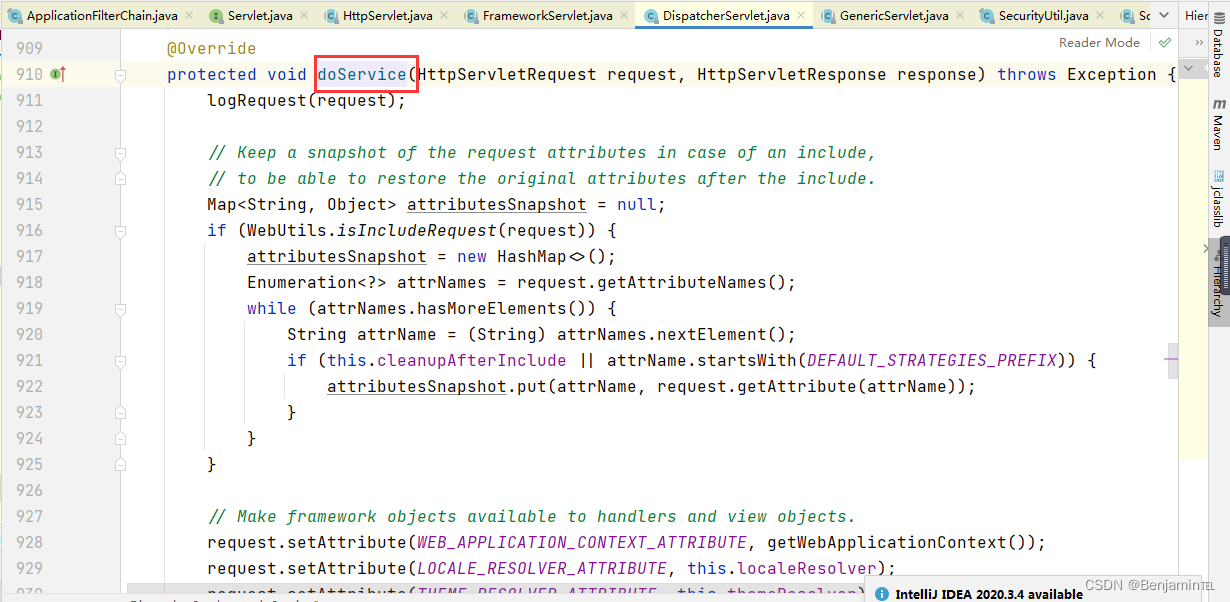
?https://blog.csdn.net/z69183787/article/details/129240218
https://blog.csdn.net/sunshinezx8023/article/details/128630710
本文来自互联网用户投稿,该文观点仅代表作者本人,不代表本站立场。本站仅提供信息存储空间服务,不拥有所有权,不承担相关法律责任。 如若内容造成侵权/违法违规/事实不符,请联系我的编程经验分享网邮箱:chenni525@qq.com进行投诉反馈,一经查实,立即删除!
- Python教程
- 深入理解 MySQL 中的 HAVING 关键字和聚合函数
- Qt之QChar编码(1)
- MyBatis入门基础篇
- 用Python脚本实现FFmpeg批量转换
- 如何定义眼图测试模板
- vim基础,高端程序员如何Termux里编写代码
- 第7章-第4节-Java中的Set集合和自然排序compareble
- 第八章 创建Callout Library - ZFentry 链接选项
- Python通过telnet批量管理配置华为交换机
- 基于QTreeWidget实现多级组织结构
- Java版直播商城:电商源码、小程序、三级分销及 免 费 搭 建 方案
- Java对接大华云睿摄像头(人流统计/客流量统计)
- 德思特干货丨如何使用SBench6软件对数字化仪采集信号进行处理?(二)——平均运算功能
- 百家大吉·夕阳关爱——昌岗街微型养老博览会